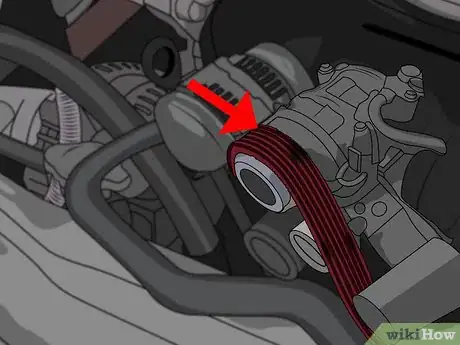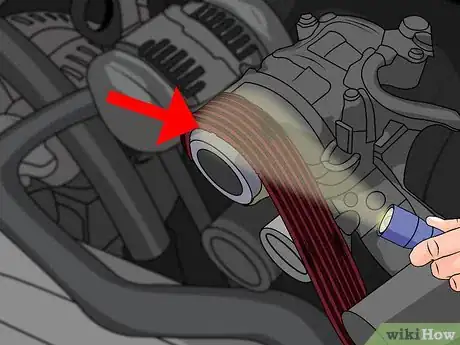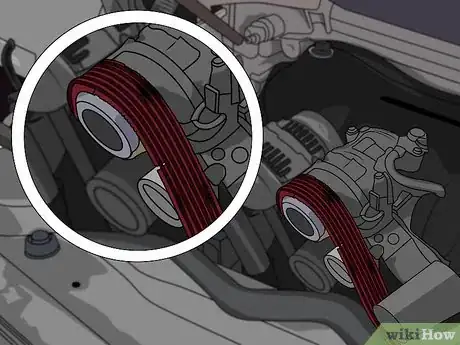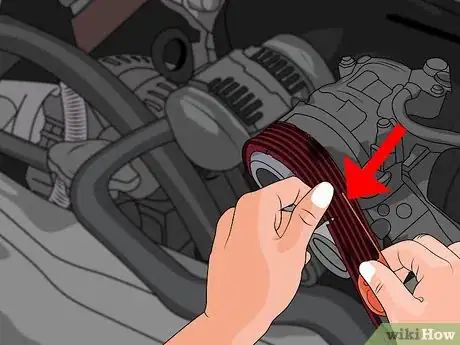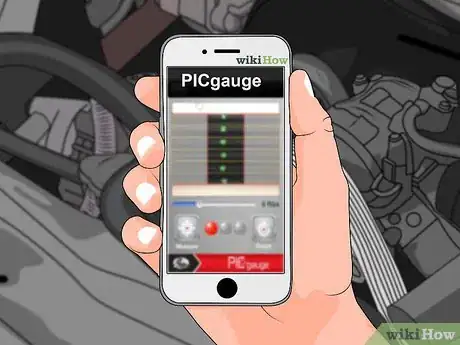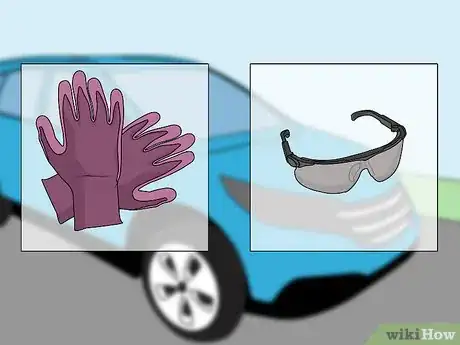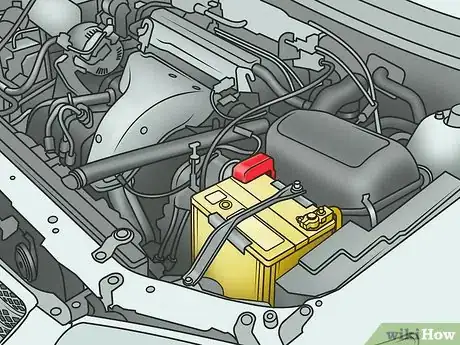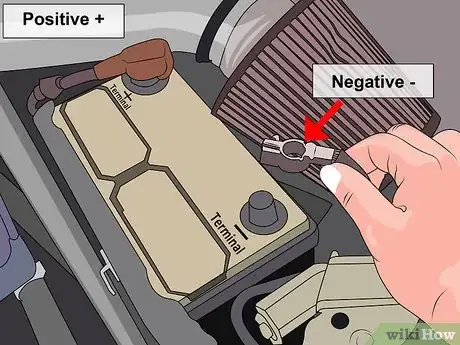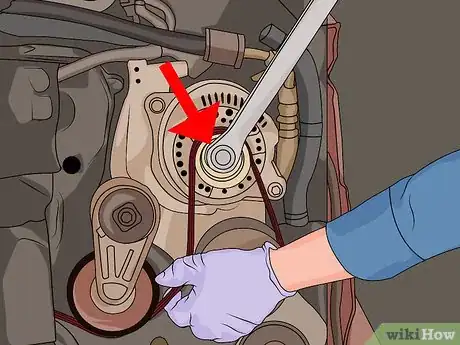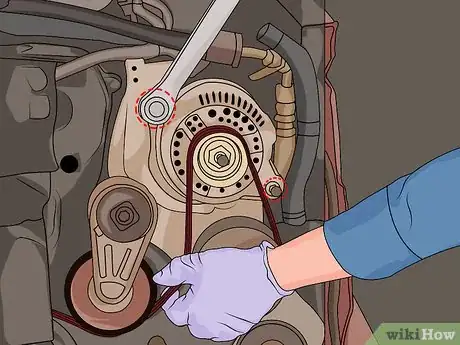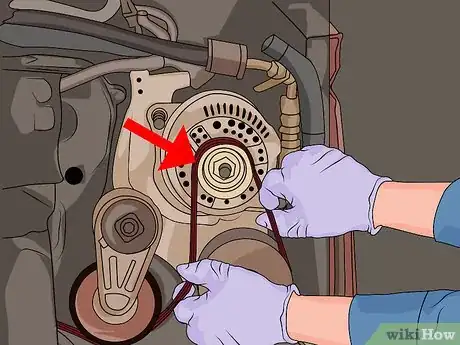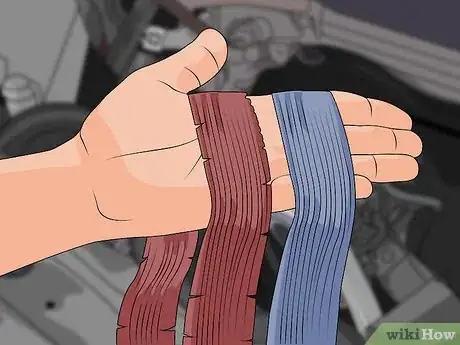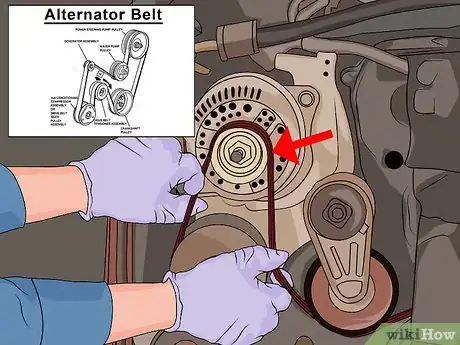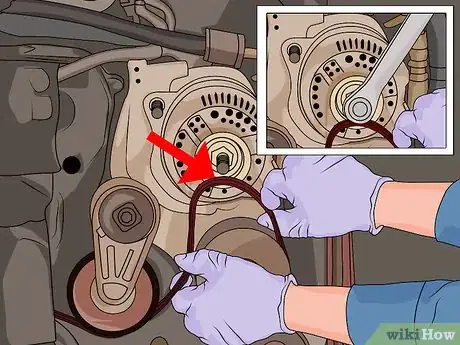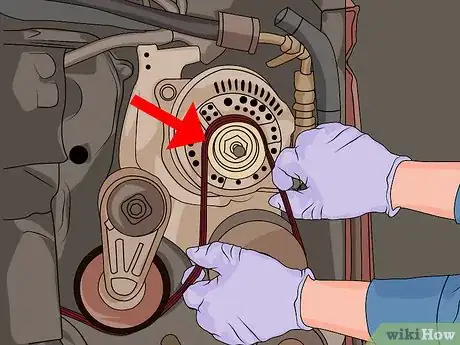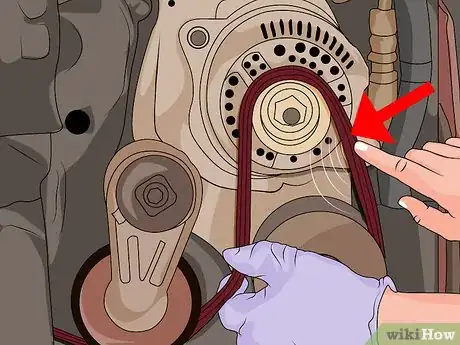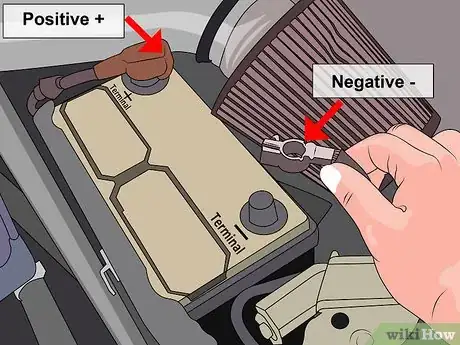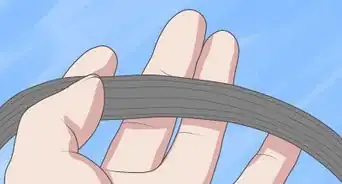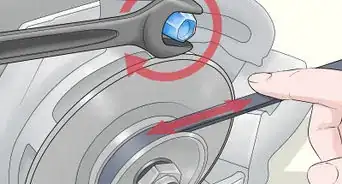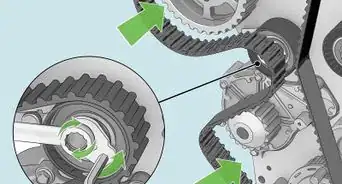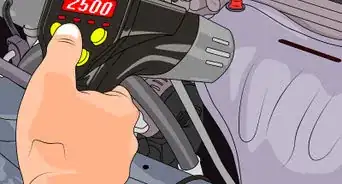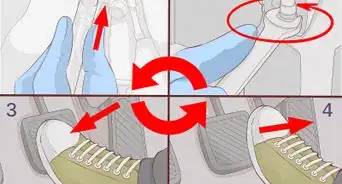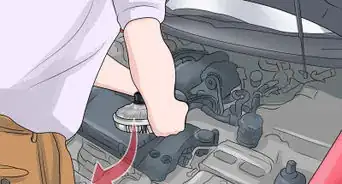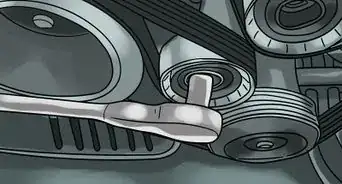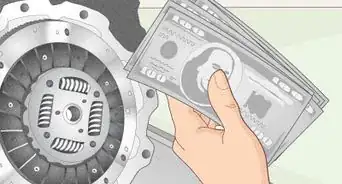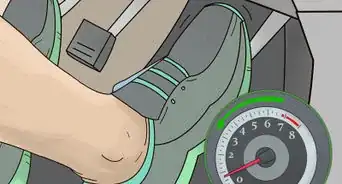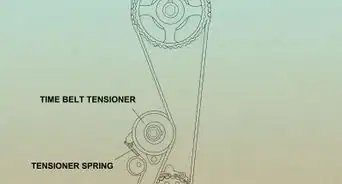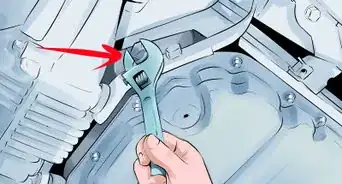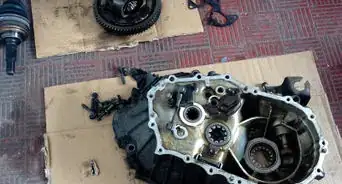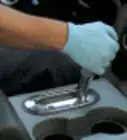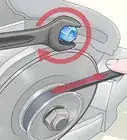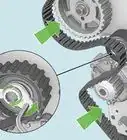This article was co-authored by Jason Shackelford. Jason Shackelford is the Owner of Stingray Auto Repair, a family owned and operated auto repair shop with locations in Seattle and Redmond, Washington. He has over 24 years of experience in auto repair and services, and every single technician on Jason’s team has more than 10 years of experience.
This article has been viewed 188,406 times.
The alternator in your vehicle produces the electrical current necessary to power the engine and charge your battery, but its ability to produce electricity can be compromised by a worn out belt. Most modern vehicles have only one belt to power all accessories called a serpentine belt, while some older vehicles may have a belt that specifically powers the alternator. Regardless of which design your vehicle uses, you will likely have to replace the belt that powers your alternator at some point in the lifetime of your vehicle. You can replace these belts yourself using common hand tools.
Steps
Determining if Your Belt Needs Replacing
-
1Locate the alternator or serpentine belt. In older model vehicles, engines often came equipped with multiple belts that each powered a different accessory. However, most modern vehicles use only one belt to power the alternator as well as the power steering, air conditioning, and any other accessories. Depending on the make and model of the vehicle, this belt (often called the serpentine belt) is often located on the front or side of the engine.[1]
- Many American made vehicles with V6 engines or larger have the serpentine or accessory belts on the front. These engines are considered “longitudinally mounted,” with the engine mounted lengthwise on the chassis.
- Many four cylinder vehicles have transverse mounted engines, meaning the engine is mounted at a ninety degree angle from the chassis, placing the belts on the side of the engine bay instead of the front.
-
2Look for cracks in the belt. A significant sign that your alternator or serpentine belt needs replacing is visible cracking along the belt. Modern serpentine belts are designed to prevent cracking and will last much longer than older accessory style belts, but all belts are prone to cracking over a long enough timeline.[2]
- If the belt appears dried out and cracks have formed, it will need to be replaced.
- Use a flashlight to get a good look at the belt in areas that aren't as visible to look for signs of cracking elsewhere on the belt.
Advertisement -
3Look for other signs of belt damage. While cracks are the most common sign of a worn out belt, there are other common signs of damage that you should be on the lookout for. Look for chunks of the belt missing in places, frayed fabric along the back of the belt, or signs that the belt has been rubbing on something.[3]
- You may want to start the engine to watch the belt moving to look for signs of damage along the entire belt.
- If something has been rubbing on the belt, you will need to identify it and move it before installing your new belt.
-
4Use a gauge to measure belt wear. Even with no visible signs of damage, your alternator or serpentine belt may still be too worn. You can purchase an inexpensive plastic belt gauge at most auto parts stores than can tell you if your belt needs to be replaced by measuring the depth of the grooves on the belt. Simply slide the gauge into one of the grooves and take note of how far it goes in.[4]
- If the plastic gauge seats into the belt far enough for the handle to make contact with the belt, it is too worn and will need to be replaced.
- You can do this test with the belt on or off of the vehicle.
-
5Use a smartphone to measure belt wear. Instead of purchasing a belt depth gauge, you can purchase and download a smartphone application that can tell you if your belt needs to be replaced. Applications like PIC gauge and Gates Programs Belt Wear allow you to simply take a picture of the belt threads to have the application analyze their depth. If it deems the depth to be too shallow, it will tell you to replace the belt.[5]
- There are applications for both iPhone and Android smartphones that can measure the depth of the tread on your belts.
- It's important to remember that the application is not an expert opinion and may not always provide accurate information.
Removing the Old Belt
-
1Put on the appropriate safety gear. Any time you work on your vehicle you should start by putting on the necessary safety equipment. Eye protection will prevent dust, fluids or debris from falling into your eyes if you have to get under the vehicle. Gloves can also provide protection against scratches, pinches and cuts that may result in working in your engine bay if you choose to wear them.
- Always wear eye protection when working on your vehicle.
- Gloves can protect your hands, but are optional for this project.
-
2Disconnect the battery. Open the hood of your car and locate the battery. It's important to note that some vehicles keep the battery in the trunk instead of the engine bay for space saving or weight distribution. Once you've located it, use a hand or socket wrench to loosen the bolt holding the ground cable to the negative terminal on the battery. The negative terminal can be identified by looking for the negative symbol (-) or the letters NEG. Loosen the bolt until you can slide the cable off of the terminal.[6]
-
1
- Tuck the cable to the side of the battery to prevent it from coming in contact with the negative terminal.
- This will ensure the engine cannot be started while you're working on it, protecting you and the engine from damage.
-
2Use a breaker bar or socket wrench to loosen the auto-tensioner. Many newer model vehicles come equipped with an auto-tensioner pulley. The pulley presses upward as the belt wraps around it so the belt remains under constant, steady tension. Use a half inch drive breaker bar or socket wrench, and slide the portion of the wrench that would normally go into a socket into the square opening in the center of the pulley. It is possible that your vehicle uses a 3/8 inch drive or even a bolt on the tensioner pulley, so refer to your particular vehicle's service manual to ensure you have the appropriate tools.[7] Rotate the wrench clockwise to relieve the pressure it is placing on the belt.
- It may take a good amount of pressure to rotate the tensioner pulley down. Be careful to release it slowly with steady pressure to avoid injuring yourself or damaging the vehicle.
- As soon as you let the tensioner go, it will return to its usual position and put pressure on the belt again, so you will need to hold it in place as you remove the belt.
- Not all vehicles are equipped with an auto-tensioner.[8] Consult your specific vehicle's service manual to see if yours is.
-
3Loosen the alternator bolts if there is no auto-tensioner. If your vehicle does not have an auto-tensioner, you can still relieve the tension on the belt by loosening the bolts attaching the alternator to the engine. As you loosen the bolts, tilt the alternator forward to create slack in the belt. Be careful not to damage the threads of the alternator bolts by allowing it to sit tilted under pressure for too long.
- If your vehicle has an alternator belt instead of a serpentine belt, this is the method you will need to use.
- Be careful not to damage the wiring going into the alternator. The alternator provides the power the engine needs to run through those wires.
-
4Slide the belt off of the pulleys and remove it from the car. Once the tension is off the belt, slide it off of the first or highest pulley. Once it is off of one pulley, you can release the auto-tensioner if that is the method you used to reduce the tension. Make a note of how the belt is wound throughout the different pulleys if it is a serpentine belt, as you will need to slide the new belt on in the same way.
- If you do not have a diagram on the vehicle or in your service manual laying out the direction your serpentine belt travels through the pulleys, take a picture of it with your phone to refer to when installing the new belt.[9]
- A strictly alternator belt will likely only go around an alternator pulley and the crank pulley at the bottom of the engine.
Installing a New Alternator Belt
-
1Compare the lengths of the new and old belts. Before you begin installing the new belt, compare it to the old one to ensure it is the proper length and width.[10] Different vehicles have different sized belts and installing the wrong size could result in failing to power the accessories or even damage to the engine. [11]
- If your old belt was loose because it had stretched over time, take that into consideration when comparing the two belts.
- Make sure both belts have the same number of “ribs” or threads spanning the width of the belt.
-
2Run the new belt through most of the pulleys. Using a diagram or the picture you took to guide you, snake the new belt around all the necessary accessory pulleys except the auto-tensioner or alternator (depending on whether or not your vehicle came equipped with an auto-tensioner). With many serpentine belts, this can be difficult, as some pulleys will be hard to access with your hands, so be patient and make sure to seat the belt properly around each.[12]
- You will need to keep tension on the belt with your hands as you slide it into place to ensure it doesn't fall off while you're looping it around pulleys.
- If your vehicle has a belt only for the alternator, you will need to only slide it around the crank pulley at the bottom of the engine.
-
3Loosen the auto-tensioner and slide the new belt on. If your vehicle is equipped with an auto-tensioner, use a breaker bar or appropriately sized ratchet to lower the auto-tensioner pulley last. With the belt around all of the other pulleys, slide it over the tensioner pulley with pressure still on the breaker bar or wrench. Once the belt is in place, slowly reduce the pressure on the wrench, allowing the tensioner pulley to tighten the belt.[13]
- Do not simply release the auto-tensioner, as that could damage the belt and cause injury. Instead, reduce the pressure you place on it slowly.[14]
- Remove the wrench or breaker bar from the tensioner pulley once this is done.
-
4Slide the belt over the alternator pulley. If you loosened the alternator to remove the old belt, reverse that process by sliding the belt back over the alternator pulley. Again, take care not to place too much pressure on the loosened bolts of the alternator. If the belt is too taught to slide it over the pulley, loosen the bolts a bit more to allow the alternator to tip forward further.[15]
- Try not to remove the bolts to the alternator completely, as they will be difficult to reinstall under the pressure of the belt.[16]
- Make sure the belt seats on the alternator pulley completely.
-
5Tighten the alternator bolts. With the serpentine or alternator belt safely seated on the alternator pulley, use the same wrench you used to loosen to the bolts to tighten them again.[17] As you tighten the bolts, the alternator will stop tipping forward, which will increase the tension on the belt.[18]
- Don't tighten one bolt completely before moving to the next one. Instead tighten one halfway, then the other, before coming back to the first.
- If the belt seems to be putting too much pressure on the alternator, check again to make sure you have it run through all the other pulleys properly.
-
6Check the belt tension. Once you have released the auto-tensioner or tightened the alternator bolts, check the tension of the belt to make sure it has seated properly on all pulleys.[19] Pinch the belt between your thumb and index finger and try to wiggle it. There should be very little give to a properly installed alternator or serpentine belt.[20]
- You can purchase belt tension testers at many auto parts stores that will tell you for certain that the tension in your belt is sufficient.
- If the belt feels loose, check to make sure it has been run through all of the necessary pulleys properly.
-
7Reconnect the battery. Once the belt is securely in place, slide the ground cable back onto the negative terminal on the battery. Use the same wrench you used to remove it to tighten the bolt, then wiggle the connection with your fingers to ensure it is not loose.[21]
- Make sure the ground cable is tight and won't come off while driving.
- A loose or disconnected ground cable could cause the engine to die.
Expert Q&A
-
QuestionHow can you replace an alternator belt yourself?
 Ed BeeryEd Beery is an Automotive Specialist and the Owner of InTechgrity Automotive Excellence based in Denver, Colorado. With more than eight years of experience, he specializes in providing maintenance and repair services for both individuals and companies. Ed and the InTechgrity Automotive Excellence Team are approved by the American Automobile Association (AAA) for repairs and are Automotive Service Excellence (ASE) certified.
Ed BeeryEd Beery is an Automotive Specialist and the Owner of InTechgrity Automotive Excellence based in Denver, Colorado. With more than eight years of experience, he specializes in providing maintenance and repair services for both individuals and companies. Ed and the InTechgrity Automotive Excellence Team are approved by the American Automobile Association (AAA) for repairs and are Automotive Service Excellence (ASE) certified.
Automotive Specialist Take photos of the belt set-up before making any changes. This way, you know exactly how the belt should be routed around the various pulleys. Make sure that your photos make sense to you and are clear.
Take photos of the belt set-up before making any changes. This way, you know exactly how the belt should be routed around the various pulleys. Make sure that your photos make sense to you and are clear. -
QuestionHow do you loosen a tensioner?
 Ed BeeryEd Beery is an Automotive Specialist and the Owner of InTechgrity Automotive Excellence based in Denver, Colorado. With more than eight years of experience, he specializes in providing maintenance and repair services for both individuals and companies. Ed and the InTechgrity Automotive Excellence Team are approved by the American Automobile Association (AAA) for repairs and are Automotive Service Excellence (ASE) certified.
Ed BeeryEd Beery is an Automotive Specialist and the Owner of InTechgrity Automotive Excellence based in Denver, Colorado. With more than eight years of experience, he specializes in providing maintenance and repair services for both individuals and companies. Ed and the InTechgrity Automotive Excellence Team are approved by the American Automobile Association (AAA) for repairs and are Automotive Service Excellence (ASE) certified.
Automotive Specialist Find the tensioner bolted to the block or vehicle—it will have a square hole that accepts a 3/8 or 1/2 inch ratchet end. Attach the ratchet and rotate it to reduce the tension on the belt.
Find the tensioner bolted to the block or vehicle—it will have a square hole that accepts a 3/8 or 1/2 inch ratchet end. Attach the ratchet and rotate it to reduce the tension on the belt. -
QuestionHow do you change a belt without a tensioner?
 Ed BeeryEd Beery is an Automotive Specialist and the Owner of InTechgrity Automotive Excellence based in Denver, Colorado. With more than eight years of experience, he specializes in providing maintenance and repair services for both individuals and companies. Ed and the InTechgrity Automotive Excellence Team are approved by the American Automobile Association (AAA) for repairs and are Automotive Service Excellence (ASE) certified.
Ed BeeryEd Beery is an Automotive Specialist and the Owner of InTechgrity Automotive Excellence based in Denver, Colorado. With more than eight years of experience, he specializes in providing maintenance and repair services for both individuals and companies. Ed and the InTechgrity Automotive Excellence Team are approved by the American Automobile Association (AAA) for repairs and are Automotive Service Excellence (ASE) certified.
Automotive Specialist Loosen the bolt on the sliding mount of your alternator. If the alternator will not slide, you may need to loosen the other bolts for the alternator, but do not remove them. The sliding mount has a bolt through a slot on one of the mounting brackets that the bolt slides through.
Loosen the bolt on the sliding mount of your alternator. If the alternator will not slide, you may need to loosen the other bolts for the alternator, but do not remove them. The sliding mount has a bolt through a slot on one of the mounting brackets that the bolt slides through.
References
- ↑ http://www.familyhandyman.com/automotive/changing-a-car-serpentine-belt/view-all
- ↑ http://www.familyhandyman.com/automotive/changing-a-car-serpentine-belt/view-all
- ↑ http://www.familyhandyman.com/automotive/changing-a-car-serpentine-belt/view-all
- ↑ http://www.familyhandyman.com/automotive/changing-a-car-serpentine-belt/view-all
- ↑ http://www.familyhandyman.com/automotive/changing-a-car-serpentine-belt/view-all
- ↑ Jason Shackelford. Auto Technician. Expert Interview. 11 June 2019.
- ↑ Ed Beery. Automotive Specialist. Expert Interview. 19 November 2021.
- ↑ Ed Beery. Automotive Specialist. Expert Interview. 19 November 2021.
- ↑ Ed Beery. Automotive Specialist. Expert Interview. 19 November 2021.
- ↑ Ed Beery. Automotive Specialist. Expert Interview. 19 November 2021.
- ↑ https://www.automd.com/46/how-to-replace-a-serpentine-belt/
- ↑ https://www.automd.com/46/how-to-replace-a-serpentine-belt/
- ↑ https://www.automd.com/46/how-to-replace-a-serpentine-belt/
- ↑ Ed Beery. Automotive Specialist. Expert Interview. 19 November 2021.
- ↑ https://www.automd.com/46/how-to-replace-a-serpentine-belt/
- ↑ Ed Beery. Automotive Specialist. Expert Interview. 19 November 2021.
- ↑ Ed Beery. Automotive Specialist. Expert Interview. 19 November 2021.
- ↑ https://www.automd.com/46/how-to-replace-a-serpentine-belt/
- ↑ Ed Beery. Automotive Specialist. Expert Interview. 19 November 2021.
- ↑ https://www.automd.com/46/how-to-replace-a-serpentine-belt/
- ↑ http://www.familyhandyman.com/automotive/changing-a-car-serpentine-belt/view-all
About This Article
To put on a new alternator belt, you’ll need to disconnect your car battery and remove the old belt so you can thread the new one through the pulleys. Start by putting on eye protection and gloves to keep yourself safe as you work. Disconnect the car battery and loosen the auto-tensioner using either a breaker bar or a socket wrench. Once the tension is released, slide the belt off the pulleys. Get the new alternator belt and run it through the pulleys in the same way as the old belt, snaking it around the alternator pulley last. Use a wrench to tighten the bolts on the alternator pulley to increase the tension on the belt. Ensure that there is very little give when you try and wiggle the belt, as this shows the belt is aligned properly on the pulleys. If the belt has the correct tension, reconnect the car battery. For more information on putting on an alternator belt, like how to know when the belt needs replacing, read on.
